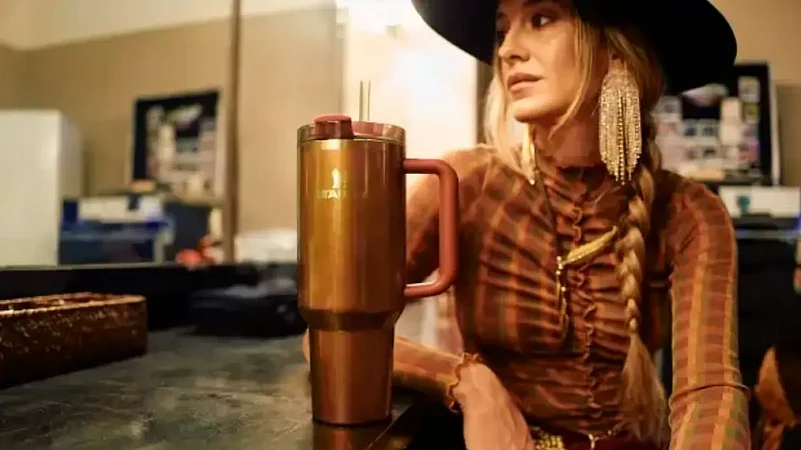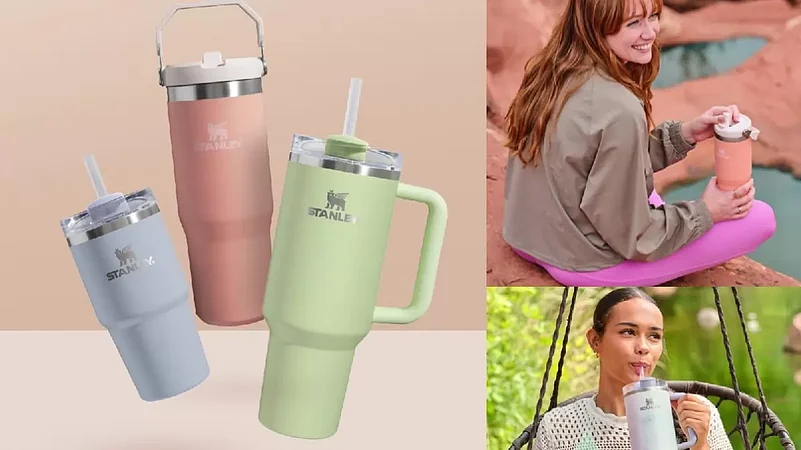On January 3rd, Stanley, the company known for its highly popular, unbreakable 40-ounce double-wall vacuum-insulated tumblers, unveiled a special collaboration with Starbucks. This viral tumbler, featuring a "Winter Pink" color, was exclusively available at Target stores, and let to extensive queues, overnight camping, and chaotic scenes at various retail locations.
Given the rush of people aggressively entering Target stores throughout the country this week, one might initially assume that the crowd was clamoring for a high-value electronic device or the most extraordinary Black Friday bargains.
However, the massive crowds of shoppers were all in pursuit of a single item - drink tumblers.
Target Stores offered the limited-edition Starbucks x Stanley 40-ounce stainless steel pink vacuum-sealed Quencher for a minimal time at the price of $49.95. However, it appears that the available stock didn't last very long, given the high demand for the product.

Devoted Stanley enthusiasts were already aware of this collaboration and were determined to acquire one, or perhaps even two or ten, depending on the purchase limits imposed.
What's the deal with the Valentine's Day cups, you ask? Well, it seems that staying hydrated in the name of love is never too early, which is why the special-edition cup was launched in late December, well over a month before Valentine's Day. Target is promoting these limited-edition cups as part of an "exclusive Galentine's Collection."
The $45 cups have already sold out on Target's website, and the company hasn't disclosed how many have been sold or whether they'll produce more. However, a Starbucks representative confirmed that the cups won't be restocked, stating that "many stores have sold out."
The demand for these highly-desired reusable water bottles is so substantial that on eBay, listings for the originally $45 tumbler are are currently fetching several hundred dollars in some cases. Clearly, the Stanley cup craze does not disappoint.
This marks the third time that a Stanley Quencher has been co-branded in collaboration with Starbucks.
With hundreds of thousands of online searches and a rapidly growing profit margin, the century-old Stanley company has experienced a significant resurgence in popularity and has successfully reached new demographics.
What are Stanley Cups?
Stanley cups, often referred to as "Stanleys," are a brand of reusable water bottles available in a diverse range of colors, patterns, and sizes. Among their product offerings, the most sought-after choice is the "The Quencher H2.0" line, which is a beverage tumbler equipped with a straw and handle, available in sizes ranging from 14 ounces to 64 ounces.

The Stanley brand boasts a century-old history, primarily catering to a customer base composed of working-class individuals with an affinity for the outdoors. Historically, their product promotion has centered on appealing to camping and hiking enthusiasts, as well as individuals engaged in labor-intensive professions like construction workers.
The brand's marketing efforts were primarily directed towards men, featuring an iconic green color scheme that became synonymous with their products, notably the green tumbler. However, in recent years, the brand has expanded its reach to include female consumers. This shift has led to a growing customer base that includes nurses, social media influencers, and even teenagers who have shown interest in purchasing their products.
“The brand really shifted from marketing mostly to men to women now,” Shelley E. Kohan, a retail management professor at Syracuse University, said of Stanley.
What made Stanleys so popular?
Stanley initially manufactured basic reusable water bottles that gained popularity among blue-collar workers and outdoor enthusiasts. It wasn't until 2016 that they introduced the tumblers, now recognized as the Quench line. Interestingly, these tumblers didn't enjoy much popularity upon their initial launch, as reported by CNBC.
In 2020, Terence Reilly, who had previously worked as an executive at Crocs, departed from the shoe company and assumed the role of president at Stanley. Shortly after taking the reins, he strategically utilized social media and influencer marketing to enhance the sales of the new product line. CNBC reported that in the same year, this approach resulted in the new line becoming the best-selling bottle for Stanley. The product's sales experienced a remarkable 275 percent surge from 2020 to 2021.
Presently, the hashtag #Stanleycup has accumulated more than 6 billion views on TikTok, with the platform serving as the primary hub for the cups' widespread popularity. It's worth noting that some of the videos using this hashtag are related to the National Hockey League's trophy. Additionally, the hashtag #Stanley on its own has garnered an impressive view count exceeding 2 billion.
TikTok hosts thousands of videos where enthusiastic teenagers and young individuals proudly display their extensive tumbler collections. Some are moved to tears while unboxing gifted tumblers, while others showcase the frenzy of crowds rushing into stores to acquire limited edition colors.
As a result of the tumblers' surge in popularity on social media, Stanley experienced a remarkable increase in company-wide revenue. CNBC reported that the revenue surged from $74 million in 2019 to an impressive $750 million in 2023.
How did Stanley cups turn into the recent consumer fetish?
The significant increase in Stanley's sales has been primarily driven by Generation Z and the influence of social media, as stated by Jenna Drenten, an associate professor of marketing at Loyola University Chicago, in an interview with USA TODAY.
According to her, Stanley Recognized the potential of this kind of brand recognition a few years ago, and decided to pivot its marketing strategy in alignment with the same.

Drenten explained, "It created tumblers in new limited edition colors, creating both scarcity and novelty. It partnered with influencers and leveraged existing online chatter." She added, "It moved the product from something useful to something aspirational. But all of this was done without compromising the quality of the product."
Stanley also recognized the power of consumer marketing through social media. “The influencers are big-time influencers, but it’s also you and me, the consumer, making videos about their experiences with the Stanley cup as an example,” Ms. Kohan said.
"You may have seen recently the instance in which a young woman’s car caught fire and the only thing remaining was a Stanley cup in tact with ice still inside," recalled Drenten. "The brand was tagged over and over again in the video and finally responded by buying the woman a new car. Social media marketing like this can’t be planned. It has to be community-oriented: letting consumers take ownership in the brand story."
Stanley effectively tapped into a new demographic and introduced tailored offerings, establishing a reciprocal relationship with a growing fan base of women and girls. For every simple video featuring a teenage girl showcasing her Stanley collection, there are many others at her school who aspire to own the same cup, according to Drenten.
"That type of peer influence in face-to-face settings is still some of the ultimate marketing," Drenten said. "Consumers are walking billboards for brands."
The hashtag #StanleyTumbler gained immense popularity and was used millions of times. The tumbler has evolved into both a fashion accessory and a coveted collector's item.
“Now this reusable cup becomes a fashion item accessory like a handbag or belt,” Ms. Kohan said. Add a special color or a limited edition, and it’s a “fashion frenzy,” she added.



























